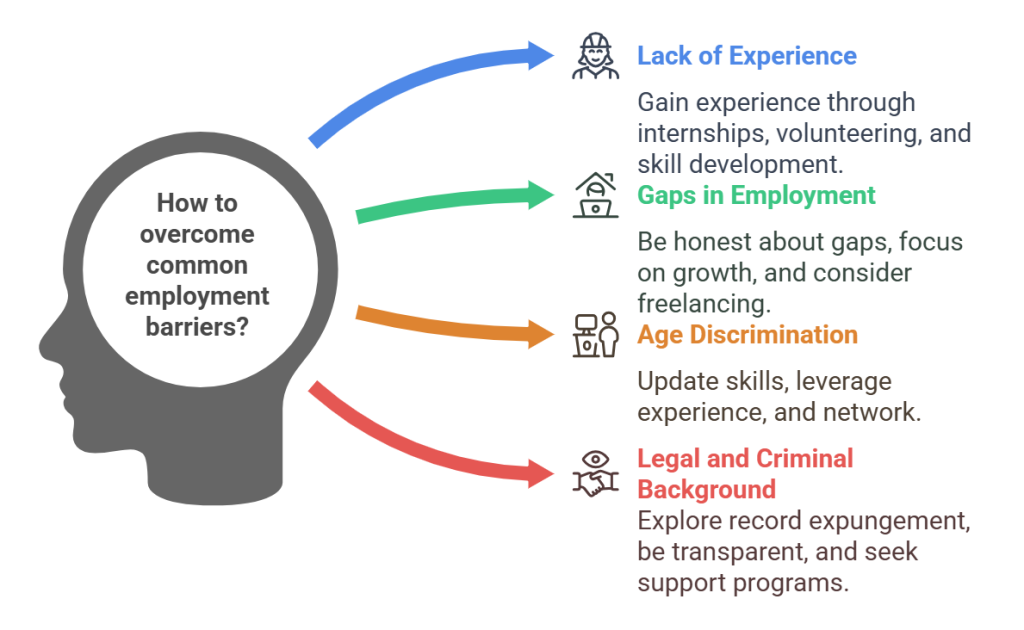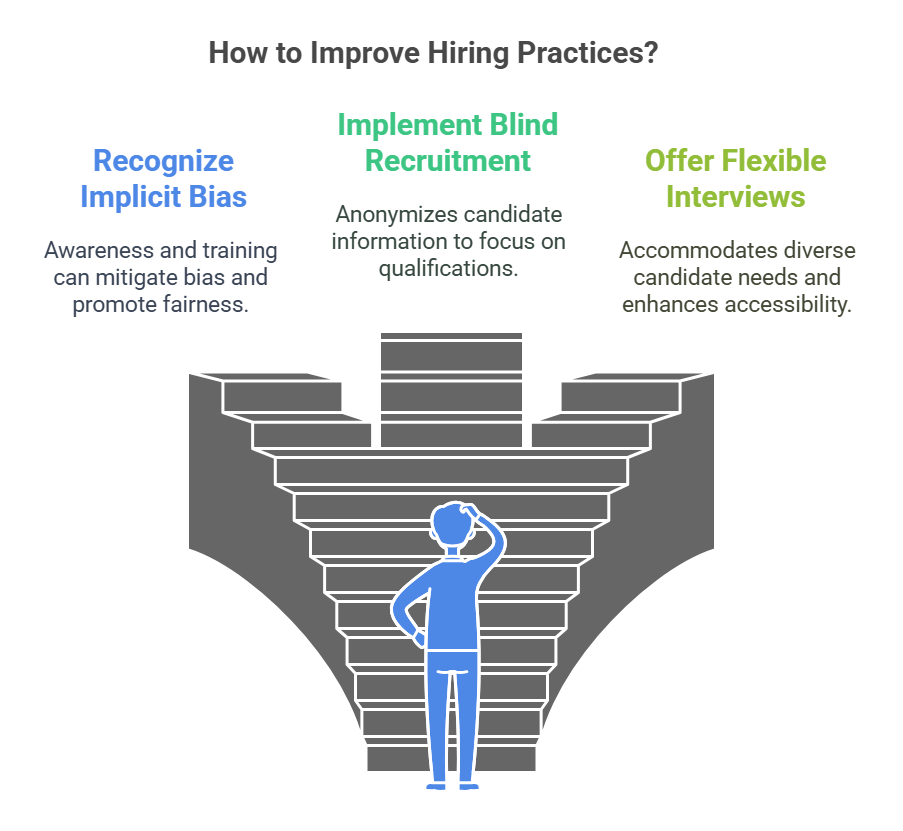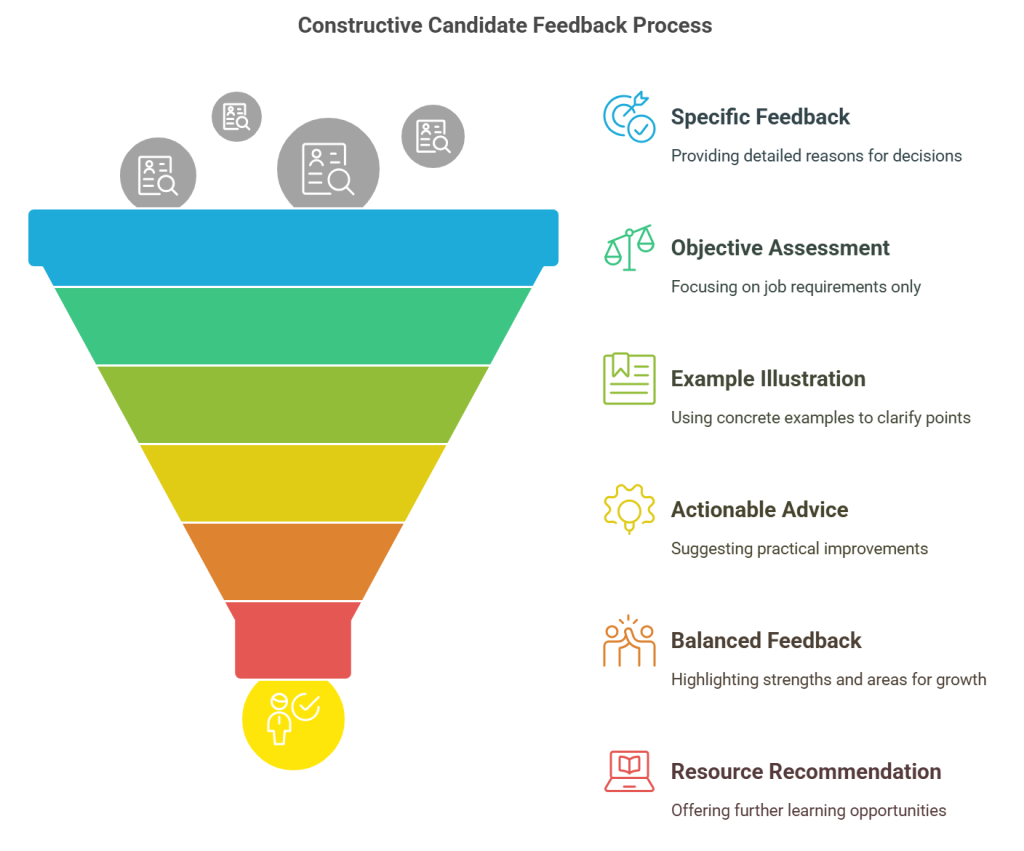Navigating the job market can be daunting, especially when faced with unique obstacles that hinder your journey toward employment. Whether you're transitioning careers, re-entering the workforce after a hiatus, or dealing with legal issues, overcoming employment barriers is crucial. This guide aims to provide actionable insights and practical advice for job seekers while offering HR professionals a deeper understanding of the challenges and solutions in the current employment landscape.
Key Takeaways
- Common employment barriers include lack of experience, gaps in employment, age discrimination, and legal/criminal backgrounds, but these can be overcome with strategic approaches such as skill development, networking, and honest communication.
- Employers can create more inclusive hiring processes by addressing implicit bias, implementing blind recruitment techniques, and offering flexible interview opportunities.
- Technology plays a crucial role in bridging employment barriers, with AI and automation enhancing candidate matching and reducing bias in initial screenings.
- Virtual job fairs and networking events have democratized access to opportunities, making it easier for job seekers facing various barriers to connect with potential employers.
- Providing clear, constructive feedback to candidates is essential for fostering growth, improving the candidate experience, and building a positive employer brand.
Introduction
The job market is tough enough without additional hurdles in your way. Employment barriers—like gaps in your resume, a lack of experience, or even a criminal record—are more common than you might think and don't have to be permanent roadblocks. For HR professionals, getting a grip on these challenges is essential for nurturing an inclusive work environment where every candidate gets a fair shot.
This guide walks you through the tangled web of employment obstacles. We’ll share actionable tips and advice for job seekers battling various barriers. At the same time, HR professionals will gain insights into crafting more inclusive hiring processes. So, let’s break down these barriers and help you navigate to a successful career.
EXPERT INSIGHT: Try and try until you succeed’ is an old saying, and though it may be ancient, it holds timeless wisdom, especially in the context of job searching. It's rare for candidates to be accepted on the first try, and recruiters seldom, if ever, interview just one person for an open role. However, merely trying isn't enough. Both candidates and HR professionals, especially in these changing times, must continuously update themselves with the latest trends and best practices to succeed. This article is packed with tips and guidance to make navigating the job search easier. - Emile Garcia, SHRM-SCP, CHRP, CHRBP
For Job Seekers: Common Employment Barriers and How to Overcome Them

The path to employment is often obstructed by various barriers that can make job searching a frustrating and demoralizing process. Identifying and addressing these barriers is crucial for job seekers aiming to secure employment and for HR professionals striving to build an inclusive workforce. Here are some of the most common employment barriers and practical ways to overcome them.
1. Lack of Experience
Not having enough experience is a common hurdle, particularly for recent graduates or those looking to pivot to a new industry. Employers often seek candidates with a proven track record, making it hard for newbies to get their foot in the door.
“How can I have two years' worth of experience if no one will even give me a shot to start working?” This question, posed by a fresh graduate eager to embark on her career journey, reflects a widespread frustration among many job seekers. Whether just out of university or attempting a career shift into a new industry, navigating this conundrum is a challenge shared by many. So, how do we overcome this?
Actionable Solutions:
- Internships and Volunteering: Consider short-term roles or volunteer positions in your desired field. These opportunities not only build up your resume but also provide valuable networking prospects.
- Skill Development: Make use of online courses and certifications to bridge the gap. Platforms like Coursera, Udemy, and LinkedIn Learning offer courses that can help you acquire the necessary skills.
- Network Building: Reach out to industry professionals for informational interviews. People love to share their expertise, and these conversations can lead to mentorship or even job referrals.
2. Gaps in Employment
More and more, gaps in employment is an accepted practice especially when it comes to prioritizing mental health, family and overall wellness. Employers are increasingly recognizing the value of well-rounded candidates who have taken the time to pursue personal growth and address life’s challenges. This shift in perspective is fostering a more compassionate and understanding workplace environment.
On the other hand, career breaks can be a red flag for employers, leaving them to question a candidate's commitment or reliability. Whether due to personal reasons, further education, or layoffs, gaps in employment can be difficult to explain.
Actionable Solutions:
- Honesty and Positivity: Be transparent about your career break on your resume and in interviews. Frame the gap as a period of growth and learning, emphasizing how it has prepared you for the role.
- Continual Learning: Use this time to pick up new skills or work towards certifications. This shows prospective employers that you are proactive and motivated.
- Freelancing and Consulting: Consider freelancing or consulting in your field to keep your skills sharp and demonstrate continuous professional activity.
3. Age Discrimination
Older job seekers often face age-based discrimination, with misconceptions about their ability to adapt to new technologies or fit within youthful company cultures. Despite these challenges, many companies are beginning to see the immense value in the experience and adaptability older workers bring to the table, fostering a more diverse and inclusive workplace.
Actionable Solutions:
- Updating Skills: Stay current with industry trends and technologies. Take courses or attend workshops to ensure your skills are up-to-date.
- Leveraging Experience: Highlight your extensive experience as a unique selling point. Bring attention to your problem-solving skills, leadership, and industry knowledge.
- Networking: Join professional associations and attend industry events. These gatherings can lead to job opportunities and help break down age-related biases.
4. Legal and Criminal Background
A criminal record can severely limit job prospects, with many employers hesitant to hire individuals with legal issues.
Actionable Solutions:
- Sealing or Expunging Records: Look into legal options to seal or expunge your record, minimizing its visibility to potential employers.
- Transparency: Be upfront about your past mistakes and focus on how you've turned your life around. Highlight the lessons learned and your steps to make positive changes.
- Programs and Support: Seek out programs to help individuals with criminal backgrounds find employment. Organizations and support networks can offer training, job placement, and advocacy services. Utilize resources such as the one available at Job Seekers with Criminal Records.
By understanding these common employment barriers and taking proactive steps to address them, job seekers can improve their chances of landing their desired roles. For HR professionals, recognizing these challenges and implementing inclusive hiring practices is key to tapping into a wider talent pool.

For Employers: Strategies for Creating an Inclusive Hiring Process

1. Understanding Implicit Bias
Implicit bias is a silent influencer, hard to notice but impactful on hiring decisions. It's the unconscious attitudes or stereotypes that affect our understanding and actions. An example of unconscious bias is the tendency to favor candidates who share similarities with the recruiter in terms of educational background, age, or race. Another example is the inclination to make generalizations based on racial stereotypes. In a hiring context, this can lead to favoring certain candidates over others based on preconceived notions rather than qualifications.
Recognizing Bias
The first step in mitigating implicit bias is awareness. HR professionals must realize that everyone harbors biases, whether they like it or not. These biases can cloud judgment and affect hiring decisions. Acknowledge that these biases exist and commit to addressing them.
Training and Awareness
Implementing regular bias training sessions can make a substantial difference. These sessions should educate staff about common biases and their implications. It's essential for training to be ongoing rather than one-off events. Keeping the conversation alive helps maintain consciousness about bias. Continued education through workshops, seminars, and e-learning modules ensures that staff remain vigilant and informed. Encouraging open discussions about employees' experiences can also promote a culture of continuous improvement and awareness.
Recognizing and combating implicit bias isn't just about fairness; it’s about enriching the workplace with diverse perspectives and experiences. With persistent effort, HR professionals can create a more equitable and dynamic hiring process.
2. Implementing Blind Recruitment
What is Blind Recruitment?
Blind recruitment is an approach designed to reduce bias in the hiring process by anonymizing candidate information that could trigger conscious or unconscious biases. This includes removing or concealing personal details such as names, ages, genders, and even educational backgrounds from resumes and applications. The goal is to focus purely on the qualifications, skills, and experiences relevant to the job, enabling a fairer assessment of all candidates.
Practical Steps
To get started with blind recruitment, consider the following steps:
- Anonymize Resumes: Use software or manual processes to strip personal information from resumes. This ensures hiring decisions are based on skills and experiences rather than demographic details.
- Standardize Applications: Implement standardized application forms that only capture information pertinent to the job requirements. This minimizes the risk of irrelevant details influencing the selection process.
- Structured Interviews: Develop a set of standardized interview questions tailored to the job role. Use these consistently across all candidates to ensure that each person is evaluated based on the same criteria.
- Resume Review Teams: Form diverse review teams to assess anonymized resumes. Multiple perspectives help catch any lingering biases and ensure a fair selection process.
- Training for Recruiters: Provide implicit bias training to everyone involved in the hiring process. This raises awareness and equips recruiters with the tools to recognize and counteract their biases.
- Use Technology: Leverage AI-driven recruitment tools to anonymize candidate information and ensure a bias-free shortlisting process. These tools can also analyze job descriptions and communication language patterns to avoid inadvertently biased wording.
By integrating blind recruitment into your hiring practices, you can foster a more inclusive workplace, attract diverse talent, and make decisions grounded in merit and capability rather than preconceived notions.
3. Offering Flexible Interview Opportunities
When it comes to the hiring process, one size definitely does not fit all. Offering flexible interview opportunities can make a world of difference for candidates facing a variety of logistical and personal barriers. Here’s how:
Accommodating Various Needs
Life is complex, and candidates come from all walks of life with different responsibilities and constraints. Some may juggle childcare, while others might care for aging parents or face other personal challenges. Flexible interview scheduling can show candidates that you value their time and understand their circumstances.
- Adjustable Time Slots: Offer multiple time slots throughout the day, including early mornings, evenings, or even weekends. This ensures candidates can select a time that doesn’t conflict with their current job, responsibilities, or other commitments.
- Revised Formats: Not everyone thrives in a traditional interview setting. Consider different formats—whether it’s a panel interview, one-on-one, or a task-based evaluation. Customizing the interview setup can help candidates present their best selves.
Virtual Interviews
Virtual interviews have transformed the hiring landscape, leveling the playing field for those facing geographical or mobility constraints.
- Accessibility and Convenience: Virtual interviews eliminate the need for travel, which can save time, reduce stress, and accommodate those with disabilities or those living in remote locations. This opens the door to a broader, more diverse talent pool.
- Technical Requirements: Make sure the virtual interview process is straightforward. Provide clear instructions on how to use the software, and be flexible with candidates who might experience technical difficulties. Offering tech support or a test run can significantly smooth this process.
- Consistency is Key: Ensure that virtual interview standards align with in-person interviews. This means clear, consistent, and professional communication, as well as a structured interview format that allows for fair comparison between candidates regardless of the medium.
By offering flexible interview opportunities, organizations not only demonstrate empathy and understanding but also gain access to a richer, more diverse array of candidates. This approach doesn’t just fill positions—it builds a workforce that better reflects the world in which we live and work.
Providing Clear and Constructive Feedback

Importance of Feedback
Providing feedback is a critical part of the hiring process. Constructive feedback helps candidates understand areas for improvement and enhances their overall experience with your organization. When done correctly, feedback can serve as a tool for growth, giving candidates a clearer picture of what employers value and expect. The loop of feedback and improvement aids in building a stronger, better-prepared candidate pool, fostering a positive reputation for your company.
How to Deliver It

Delivering feedback effectively involves a balance of honesty, specificity, and empathy. Here are some practical tips:
- Be Specific: General statements are not particularly helpful. Instead of saying, "You were not a good fit," explain why: "Your experience with digital marketing is extensive, but we were looking for more hands-on project management experience."
- Be Objective: Focus on the job requirements and how the candidate matched them. Avoid personal remarks or opinions that could be seen as subjective.
- Offer Clear Examples: Use examples from the candidate's interview or resume to illustrate your points. "During our discussion on campaign strategies, you mentioned using traditional media, whereas our focus is heavily on digital platforms."
- Actionable Advice: Provide suggestions on how the candidate can improve. "Consider gaining experience with digital project management tools like Asana or Trello to enhance your candidacy for similar roles."
- Balanced Approach: Mention strengths as well as areas for improvement. This balanced feedback fosters a constructive atmosphere. “Your communication skills and enthusiasm were noted. However, gaining more experience in X would make you even stronger.”
- Follow-Up Resources: Offer resources for improvement. Point them towards further training, certifications, or industry-specific insights that can help them bridge gaps. This can include recommending articles, courses, or professional groups.
- Timeliness: Provide feedback as promptly as possible. Timely feedback ensures that the information is fresh in both your mind and the candidate’s, making it more relevant and easier to act upon.
By embodying these principles, you set a standard for clear, constructive communication that benefits both the candidate and your organization. Ensuring candidates leave the process feeling informed and respected, even if they didn’t get the job, contributes to a positive employer brand and potentially keeps the door open for future opportunities.
Utilizing Technology to Bridge Employment Barriers
AI and Automation in Recruitment
Efficient screenings and enhanced candidate matching capabilities. These are not just buzzwords but practical solutions that AI and automation bring to the recruitment process. Automation helps companies sift through large volumes of applications quickly, ensuring that no candidate is overlooked due to human error or unconscious bias.
Efficient Screenings
AI-powered tools can screen resumes for essential qualifications and skills more objectively than a human might. This reduces the chances of bias creeping into the initial stages of hiring. By focusing strictly on the relevant qualifications, AI can give all applicants a fair shot, regardless of their background, age, or other potentially discriminatory factors.
Enhanced Candidate Matching
Machine learning algorithms can take candidate data and more accurately match individuals to suitable roles. This not only speeds up the hiring process but also improves the quality of matches. The more data these systems process, the better they understand what makes a candidate suitable for a specific role. This is particularly useful for job seekers who might have less conventional career paths but possess highly relevant skills.
In essence, AI and automation can democratize the job search process, making it more inclusive and efficient for everyone involved.
Virtual Job Fairs and Networking Events
Accessibility is crucial when talking job hunts, especially for those facing barriers. Enter virtual job fairs and networking events. These online platforms have democratized access to opportunities, stripping away geographical constraints and other logistical hurdles. Attending a job fair or a networking event no longer requires commuting, finding child care, or setting aside an entire day.
Platforms like Zoom, Hopin, and Brazen offer dynamic environments where job seekers can interact with potential employers from home. These virtual venues often mimic the layout of traditional job fairs but do so through webinars, live chats, and even virtual booths where participants can chat.
To maximize the benefits, preparation is key. Have your digital resume and professional profiles up to date. Familiarize yourself with the platform beforehand to avoid technical hiccups. Treat it like a face-to-face meeting: dress professionally and ensure your background is neutral and tidy. Networking digitally may lack the personal touch of a handshake, but it compensates with broader reach and flexible timing, making it a powerful tool for overcoming employment barriers.
Conclusion
Navigating the job market with employment barriers can be challenging, but with the right strategies and a supportive network, it is entirely possible to find success. For job seekers, taking small, actionable steps—whether it's gaining experience through unconventional means, addressing gaps with honesty, updating skills, or confronting legal hurdles directly—makes a significant difference. Remember, every setback is an opportunity to pivot and grow.
For HR professionals, the onus is on you to carve pathways toward inclusivity. By recognizing bias, adopting blind recruitment practices, offering flexible interview options, and providing constructive feedback, you contribute to candidates' individual success and a richer, more diverse organizational culture. Utilizing technology can bridge many gaps, offering efficiency and fairness in recruitment processes.
In summary, the key to overcoming employment barriers lies in combined efforts. Job seekers need resilience and strategic actions, while HR professionals must cultivate fair and supportive hiring practices. Together, these efforts can transform the job market into a more inclusive space, unlocking potential and opportunities for all.
Stay proactive, stay motivated, and never underestimate the power of perseverance. The road might look tough, but you'll get there with the right map and a clear destination. So, take these strategies to heart and start dismantling those barriers today.
Still have questions?
Get in touch with our team today for a personalized demo and discover how our tailored volume pricing and packages can drive results for your business!
How useful was this page?*
Note: your comments are anonymous. We use them to improve the website. Do not include any personal details.
Visit our FCRA Compliance Tool or leave a message here if you need a response.
From the blog Explore the GCheck Content Hub

Building a Strategic Screening Framework for International Hires in 2026
14 Jan, 2026 • 15 min read
Drug Testing Policies for Remote Employees: A 2026 Compliance and Strategy Guide
13 Jan, 2026 • 21 min read
Best Background Checks for Temporary Workers: A Strategic Framework for 2026
13 Jan, 2026 • 15 min readThe information provided in this article is for general informational and educational purposes only and should not be construed as legal advice or a substitute for consultation with qualified legal counsel. While we strive to ensure accuracy, employment screening laws and regulations—including but not limited to the Fair Credit Reporting Act (FCRA), Equal Employment Opportunity Commission (EEOC) guidelines, state and local ban-the-box laws, industry-specific requirements, and other applicable federal, state, and local statutes—are subject to frequent changes, varying interpretations, and jurisdiction-specific applications that may affect their implementation in your organization. Employers and screening decision-makers are solely responsible for ensuring their background check policies, procedures, and practices comply with all applicable laws and regulations relevant to their specific industry, location, and circumstances. We strongly recommend consulting with qualified employment law attorneys and compliance professionals before making hiring, tenant screening, or other decisions based on background check information.

